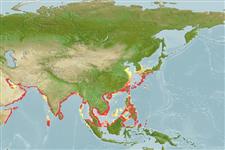>
Clupeiformes (Herrings) >
Dorosomatidae (Gizzard shads and sardinellas)
Etymology: Nematalosa: Greek, nema, -atos = filament + Latin, alausa = a fish cited by Ausonius and Latin, halec = pickle, dealing with the Greek word hals = salt; it is also the old Saxon name for shad = "alli" ; 1591 (Ref. 45335).
More on author: Bloch.
Environment: milieu / climate zone / depth range / distribution range
экология
морской; пресноводный; солоноватоводный; анадромный (Ref. 51243); пределы глубины 0 - 30 m (Ref. 6898). Tropical; 38°N - 1°N, 47°E - 136°E (Ref. 188)
Indo-West Pacific: Gulf of Aden north to the Persian Gulf, then eastward to the Andaman Sea, South China Sea and the Philippines, and north to southern tip of Korea. Also reported from Durban Bay in South Africa based on a single juvenile (Ref. 3259).
Length at first maturity / Size / Вес / Возраст
Maturity: Lm 16.2 range ? - ? cm
Max length : 27.2 cm TL самец/пол неопределен; (Ref. 122095); common length : 15.0 cm SL самец/пол неопределен; (Ref. 188)
колючие лучи спинного плавника (общее число): 0; членистые (мягкие) лучи спинного плавника (общее число): 15-19; колючие лучи анального плавника 0; членистые (мягкие) лучи анального плавника: 21 - 25. Diagnosis: Body rather deep, its depth about 34-41% of standard length, belly with 17-20 + 9-13 scutes, total 28-32 scutes; anterior arm of pre-operculum with the third infra-orbital bone immediately above it, no fleshy gap between; mouth inferior, lower jaw strongly flared outward; last dorsal finray filamentous; pectoral axillary scale present; hind edge of scales distinctly toothed; a dark spot behind gill opening (Ref. 188). Resembles Nematalosa galatheae, which has spots along the flank and a smooth hind edge to scales; Nematalosa arabica, N. come and N. japonica all have a distinct fleshy triangular area above the anterior arm of the pre-operculum and none have toothed scale edges; no other clupeid in the distribution area of Nematalosa nasus has a filamentous dorsal finray (Ref. 188).
Known from estuaries and coastal areas, occasionally ascending into the upper reaches of the tidal zone (Ref. 12693). A filter-feeder. Marketed fresh, dried-salted or boiled. Made into fish balls. Very bony.
Whitehead, P.J.P., 1985. FAO Species Catalogue. Vol. 7. Clupeoid fishes of the world (suborder Clupeoidei). An annotated and illustrated catalogue of the herrings, sardines, pilchards, sprats, shads, anchovies and wolf-herrings. FAO Fish. Synop. 125(7/1):1-303. Rome: FAO. (Ref. 188)
Статус Красного Списка МСОП (Ref. 130435)
Угроза для людей
Harmless
Использование человеком
рыболовство: не имеет хозяйственного значения
дополнительная информация
ссылкиаквакультура (рыбоводство)особенности рыбоводствастепень растяжениягенетикаElectrophoresesнаследуемостьболезниобработкаNutrientsMass conversion
соавторыизображенияStamps, Coins Misc.звукиCiguateraскоростьтип плаванияжаберная областьOtolithsмозгзрение
инструменты
Специальные отчеты
Скачать в формате XML
ресурсы в Интернет
Estimates based on models
Preferred temperature (Ref.
123201): 25.2 - 29.2, mean 28.6 °C (based on 1229 cells).
Phylogenetic diversity index (Ref.
82804): PD
50 = 0.5005 [Uniqueness, from 0.5 = low to 2.0 = high].
Bayesian length-weight: a=0.00891 (0.00780 - 0.01019), b=3.04 (3.00 - 3.08), in cm total length, based on LWR estimates for this species (Ref.
93245).
Trophic level (Ref.
69278): 2.2 ±0.09 se; based on food items.
устойчивость к внешним воздействиям (Ref.
120179): высокий, минимальное время удвоения популяции до 15 месяцев (Preliminary K or Fecundity.).
Prior r = 1.13, 95% CL = 0.74 - 1.69, Based on 2 stock assessments.
Fishing Vulnerability (Ref.
59153): Low vulnerability (17 of 100).
Climate Vulnerability (Ref.
125649): Low vulnerability (16 of 100).
Nutrients (Ref.
124155): Calcium = 235 [125, 406] mg/100g; Iron = 1.85 [1.05, 3.13] mg/100g; Protein = 18.8 [17.6, 19.9] %; Omega3 = 0.356 [0.203, 0.646] g/100g; Selenium = 40.2 [19.5, 82.2] μg/100g; VitaminA = 16.5 [6.1, 40.6] μg/100g; Zinc = 2.19 [1.54, 3.23] mg/100g (wet weight);
